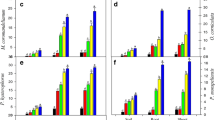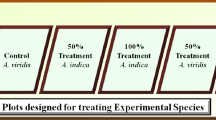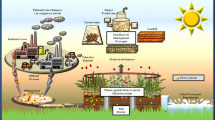Abstract
Presently the environment is heavily polluted by various toxic metals, which creates danger for all living beings. Heavy metals are toxic above certain threshold levels. Phytoremediation is an emerging technology which is quite a novel technique of cleaning polluted sites through the use of plants. Phytoremediation methods are comparatively cheap and ecologically advantageous, compared to conventional and physicochemical methods like precipitation, evaporation and chemical reduction. In this respect, plants can be compared to solar-driven pumps capable of extracting and concentrating certain elements from their environment. Amaranthus spinosus, an invasive weed seen on road sides and bare land belonging to the family Amaranthaceae, was selected for the present study. A greenhouse experiment was conducted and consisted of a range-finding test and definitive test for various concentrations of heavy metals Cu, Zn, Cr, Pb and Cd. Plants were grown in soil treated with different concentration of metals depending upon the threshold level. The bio-organics of the plant such as soluble sugar, protein, lipid, phenol, amino acid and photosynthetic pigments were estimated after 30 days of treatment. The bio-organics showed profound variation in response to accumulation of heavy metals. Accumulation of Cu, Pb and Cd was high in the roots followed by stem and leaves and that of Zn and Cr remained high in aerial parts. A steady increase was noticed in the bioaccumulation of copper, zinc and cadmium on enhancing the concentration of the corresponding metal in the soil. The bioconcentration factor and translocation factor were above unity in most of the treatments and increased as the concentration of treatment increased which indicated that A. spinosus is a potential agent for heavy metal accumulation and translocation.














Similar content being viewed by others
References
Pulford, I. D., & Watson, C. (2003). Environment International, 29, 529–540.
Sharma, P. D. (2007). Ecology and environment (pp. 501–502). Meerut: Rastogi Publications.
Jonnalagadda, S. B., & Nenzou, G. (1997). Journal of Environmental Science and Health, 32, 455–464.
Bigaliev, A., Boguspaev, K. and Znanburshin, E. (2003). Phytoremediation potential of Amaranthus sp. for heavy metals contaminated soil of oil producing territory. 10 th Annual International Petroleum Environmental Conference. Houston, al-Farabi Kazakh.
Mellem, J.J. (2008). Phytoremediation of heavy metals in Amaranthus dubius. http//fri.duct.ac.za.bils.tream/10321/315.pdf. Accessed 16 Jan 2009.
Watanabe, T., Murata, Y., & Osaki, M. (2009). Soil Science and Plant Analysis, 40(19–20), 3158–3169.
Prasad, M. N. V. (2001). Metals in the environment: Analysis of biodiversity (p. 504). New York: Marcer Dekker.
Roe, J. H. (1955). Journal of Biological Chemistry, 208(2), 889–896.
Lowry, O. H., et al. (1951). Journal of Biological Chemistry, 193, 265–275.
Bligh, E. G., & Dyer, W. J. (1959). Canadian Journal of Biochemistry and Physiology, 37, 911–917.
Malick, C. P., & Singh, M. B. (1980). Plant enzymology and histoenzymology (p. 286). New Delhi: Kalyani Publishers.
Arnon, D. I. (1949). Plant Physiology, 24, 1–15.
APHA. (1992). Standard methods for the examination of water and waste water. 18th edn., APHA-AWWA-WPCF, 1134 pp.
Ghosh, M., & Singh, S. P. (2005). Applied Ecology and Environmental Research, 3(1), 1–18.
Marchiol, L., Assolari, S., Sacco, P., & Zerbi, G. (2004). Environmental Pollution, 132, 21–27.
Vajpayee, P., Sharma, S. C., Tripathi, R. D., Rai, U. N., & Yunus, M. (1999). Chemosphere, 39(12), 2159–2169.
Sidlecka, A., & Baszynski. (1993). Physiologia Plantarum, 87, 199–202.
Yoon, J., Cao, X., Zhou, Q., & Ma, L. Q. (2006). Science of the Total Environment, 368(2–3), 456–464.
Jarvis, M. D., & Leung, D. W. M. (2002). Environmental and Experimental Botany, 48(1), 21–32.
Verkleij, J. A. C., & Schat, H. (1990). Heavy metal tolerance in plants-evolutionary aspects (pp. 179–193). Boca Raton: CRC Press.
Shukla, U. C., Singh, J., Joshi, P. C., & Kakkar, P. (2003). Biological Trace Element Research, 92(3), 257–274.
Author information
Authors and Affiliations
Corresponding author
Rights and permissions
About this article
Cite this article
Chinmayee, M.D., Mahesh, B., Pradesh, S. et al. The Assessment of Phytoremediation Potential of Invasive Weed Amaranthus spinosus L.. Appl Biochem Biotechnol 167, 1550–1559 (2012). https://doi.org/10.1007/s12010-012-9657-0
Received:
Accepted:
Published:
Issue Date:
DOI: https://doi.org/10.1007/s12010-012-9657-0




